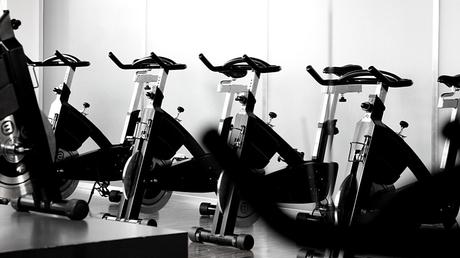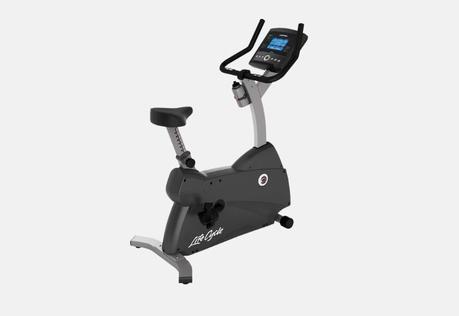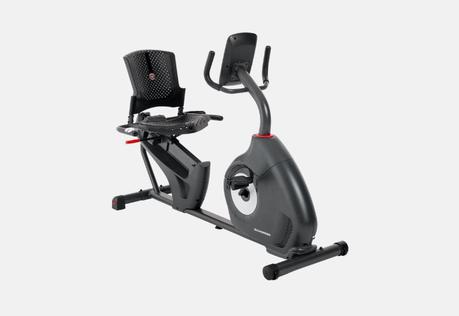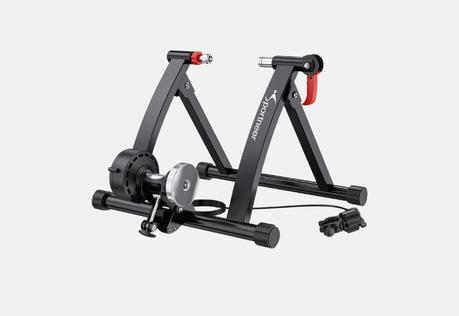Wondering which stationary bike is right for your fitness goals? Here’s a deeper look at the different types of stationary bikes, including the pros and cons of each.

The stationary bike is one of the most popular of the cardio machines, but I’ve also found it to be one of my favorite—and one of the best for getting in a hardcore lower body-focused workouts.
On those days when I’ve hammered my Chest or Back, it’s the perfect machine to finish off with a fat-burning cardio session that gives my upper body a break. Easily one of the best cardio machines for weight loss in my opinion!
But with so many different types of exercise bikes in the gym, it can be tough to pick which is the best to use. It becomes even more difficult when trying to decide which stationary bike to purchase for at-home use!
That’s where we come in…
This article will introduce you all the different types of exercise bikes, looking at what makes them great, where they might fall short, and what you need to know about them.
By the end of this post, you’ll know exactly which stationary bike will be the best not only for cardio workouts at the gym, but also give you options for great at-home cardio workouts for beginners and trainees of all experience levels.
The Different Types of Exercise Bikes
Stationary Bike
The stationary bike—also called the “upright bike”—is the classic OG model, the one that started it all.
Stationary bikes are designed to mimic exactly the build and feel of a regular bike, be it mountain bike, road bike, or dirt bike.
Originally, stationary bikes were actually just regular bikes mounted on a metal stand that elevated it off the ground to allow the wheels to spin when you pedaled.

Modern stationary bikes have a more advanced design—usually including a magnetic flywheel to add/decrease resistance and an LCD/LED display panel to track your workout performance—but the purpose is just the same.
The great thing about the standard stationary bike is that it’s very much a “what you see is what you get” machine.
If you’ve ever ridden a regular bike at any point in your life, you can hop onto the stationary bike and you’ll instantly be familiar with the way the pedals work, where to place your hands, and how to sit properly. Even the newbiest of newbies can get in a good workout on the stationary bike!
Upright bikes also tend to have thicker-padded seats, making them a more comfortable ride. They’re a very versatile choice, and tend to be the most budget-friendly, too.


Easy to master; very short learning curveNot the best for high-intensity workouts
Very comfortable compared to a regular bike
Built-in screen makes it easy to track your workout performance
All around “workhorse” model
Spin Bike
If you’ve never taken a spinning class, you are absolutely missing out!
Spinning is a high-energy, often high-intensity, stationary bike workout that gets you pedaling to the beat of music. The more upbeat the music, the faster you pedal. Or, you can pedal steadily to “slower” music, but don’t think your instructor will take it easy on you.

On the contrary: a slower beat typically means pedaling at high resistance (to simulate uphill), pedaling standing up, and/or pedaling while hovering your butt backward to target your quads and glutes.
For such a varied workout, it stands to reason you need a versatile bike. And that’s exactly what the spin bike is: a machine purpose-built for the sort of workouts you’ll do in a spinning class.
The spin bike usually is built with a “slimmer” design, feeling more like a sleek, speedy road bike than a mountain bike. Some of its unique features are:
- A heavier flywheel (usually between 30 and 50 pounds) so you can generate sufficient resistance to add a real challenge to your cycling workout.
- A knob or lever that makes it easy to manually adjust the resistance while cycling.
- Adjustable handle and seat positioning—both height and forward/backward position.
- Straps or a foot “cage” that allows you to pull upward when pedaling, helping you drive with more power with every step.
Some of the more advanced spin bikes—for example, the Echelon or Peloton—will feature high-tech screens that not only track your workout, but connect you to video lessons, live classes, interactive platforms, and communities of fellow spinning lovers.
The spin bike is definitely the most “advanced” of all the exercise bikes, built for a hardcore, varied, and ultra-fun workout!


The most versatile and advanced of the exercise bikesAmong the priciest exercise bikes on our list
Sleek and slim design; doesn’t take up too much space
Built for a varied and hardcore workout
Ultra-adjustable seat and handle positioning
Air Bike
For those who like a real challenge, the air bike (or assault bike) is the one for you.
Instead of a metal flywheel with magnets that adjust resistance, the air bike features a front “wheel” that is essentially a giant fan that spins when you pedal it. As per the laws of physics, the faster the fan spins, the more air resistance it creates. Translated simply: the faster you pedal, the harder it becomes to pedal!

The air bike also comes with moving handles that you pump (push and pull) while you cycle. This is excellent for not only developing strong upper body muscles (chest, upper back, shoulder, biceps, and triceps), but also for hammering your core.
The air bike delivers a full body workout far superior to any other machine in the gym.
What’s great about the air bike is that it can burn an INSANE number of calories. The bike has more than earned its nickname “The Devil’s Tricycle” because of how challenging it is—pedaling at a high speed, you can burn as many as 20 to 30 calories per minute. That’s 600 to 900 in half an hour, or 1200 to 1800 calories per hour!
You can’t really get a “standard” stationary bike workout with the air bike; it’s purpose-built to deliver a hardcore full body training session every time you use it.


Full body workoutNot the most versatile machine; you can’t use it for other stationary bike workouts
Burns A LOT of calories
Develop muscle while you burn fat
Recumbent Bike
The recumbent bike is designed specifically for those with joint problems, be they knee, back, hip, or ankle joints.
Instead of sitting above the pedals (as you do on the other types of exercise bikes), you sit behind the pedals, so you pedal forward and backward rather than up and down.
This pedal placement, along with the supportive design of the recumbent seat, minimizes the amount of strain on your lower back, hip, knee, and ankle joints. It basically just makes the pedaling process a whole lot easier and gentler on your skeletomuscular system overall.

The chair is comfortable, thickly padded, and even has a slight recline so your lower back is fully supported while you pedal. This makes it an excellent machine for anyone who is trying to rehabilitate their lower body without incurring or exacerbating lumbar strain.
On the downside, there’s no real core engagement. The chair is too supportive, so your abs and lower back don’t have to engage at all to keep your body upright while you pedal. Your legs are doing all the work with zero activation of your core or upper body muscles.
Another downside is that the recumbent bike works your leg muscles differently. It’s largely focused on your quads, with minimal glute and hamstring engagement. And because you can’t stand up, there’s really no way to adjust the focus to pay more attention to your posterior-chain muscles.
At the end of the day, the recumbent bike is an amazing choice for anyone who wants a low-effort, low-impact workout that’s great for rehab. Anyone who wants to challenge themselves and really push their fitness, however, will be better off with one of the other exercise bike types.


Great for rehabilitating injured jointsNo core engagement
Gentle lower body workout that you can do even while recovering from back painMinimal glute and hamstring engagement
Low-effort exercise great for the elderly or very beginner traineesDifficult to push to high-intensity or high-effort exercise
Folding Bike
Last, but definitely not least, we’ve got the most portable of all the stationary bikes: the folding bike.
As its name suggests, the folding bike is designed to fold up. Typically, it will fold up small enough that you can lean it against the wall, set it beside or behind another exercise machine, or even tuck it away in a cupboard or closet out of the way.
The folding bike is an excellent choice for any home gym that doesn’t have a lot of space to accommodate a wide variety of machines.

For example, maybe you work out in your garage, but you have to keep one half of the garage free for vehicles. Or perhaps you really can only work out in your living room (when no one is using it), so you don’t want to clutter it up with workout machines. Or maybe your basement workout room already has a treadmill, squat rack, bench press, and dumbbell rack, and there’s no more room along the walls to fit another machine.
In any of these cases, the folding bike is a good option. You can fold the bike down small enough that it won’t be in your way when using your home spaces or working out in your home gym, then unfold it when it’s time to get in your cardio.
Because its primary design feature is “foldable”, it’s not going to be the sturdiest of the exercise bikes. It’s also not quite as versatile—fewer adjustable features, a less advanced monitor with fewer pre-programmed options, etc.
Overall, however, if you want to train at home and have limited space, folding bikes are a budget- and space-friendly option well worth considering.


Takes up very little space when folded downNot the sturdiest or most versatile
Inexpensive
Great to have on hand if you want a quick workout in the middle of the day
Honorable Mention: Bike Trainer
The bike trainer isn’t exactly a stationary bike per se, but I still thought it deserved an honorable mention in this article because it’s another option to consider.
The bike trainer is basically a metal frame that you put your regular road/mountain/dirt bike on to elevate the wheels, turning it into a stationary bike.

They’re a great option if you want to train on your usual bike over the winter months when it’s too cold to be outdoors, though fair warning: they’re not always cheap (some can cost as much as $1,000) and may put additional wear on the bike (especially if the trainer clamps to the rear tire).


Turns your regular bike into a stationary bike in minutesMay put wear and tear on your bike
Many budget-friendly options
Could be cheaper and more space-smart than buying an exercise bike on top of your regular bike
Types of Exercise Bikes – FAQs
What is the difference between a spin bike and stationary bike?
A spin bike comes with more features than the average stationary bike, including adjustable handlebars, adjustable seat, a lever that makes it easy to quickly raise and lower resistance, reinforced foot strap or “cage” for harder pedaling, and (in higher-end models) a more advanced monitor that tracks more workout metrics.
Don’t get me wrong: you can use a stationary bike for a spinning workout, and a spinning bike can definitely be used for your standard stationary bike workout.
But if you plan on participating regularly in spinning classes, it’s worth buying and using a spin bike purpose-built for the workouts.
Is the exercise bike or treadmill better?
Comparing the treadmill vs stationary bike is a bit like comparing apples to oranges—both are awesome, both appeal to different people, and either can be the better choice for different people.
For example, if you’re all about that cycling life, you’ll want to spend more time training on the stationary bike to develop the specific muscles you’ll use while cycling and train for cycling endurance. On the other hand, if you’re a runner, the treadmill just makes more sense.
Overall, the treadmill is a slightly better choice for someone who neither runs nor cycles, because it burns more calories. But both are great options to consider!
The Bottom Line
As you saw above, there are a lot of different types of stationary bikes to choose from, and each model is built to serve a different purpose (or variety of purposes).
Which you select for your home gym is entirely dependent on what type of workouts you plan to do.
For the truly active athlete who wants a full-body challenge, the air bike is your best pick. For those who like the interactivity and variety of a spin class, the spin bike is a clear winner.
For anyone who wants to use the bike for rehab or low-impact training, the recumbent bike is the go-to option. For everyone else who just wants a standard, straightforward training session, the stationary bike may be a great choice.
More Articles and Guides Like This
Elliptical Machine vs Stationary Bike: Which One is a Better Workout? Wondering if the elliptical or the stationary bike is going to get you to your workout goals faster? Here’s a detailed look at the pros and cons of each. To the cardio machines!
Rowing Machine vs. Stationary Bike – Which is Best for Your Workouts? The rowing machine and stationary bike are two of the most popular cardio machines in the gym. But which one is best for you? Read on as we highlight the key differences and who each cardio machine is perfect for.
